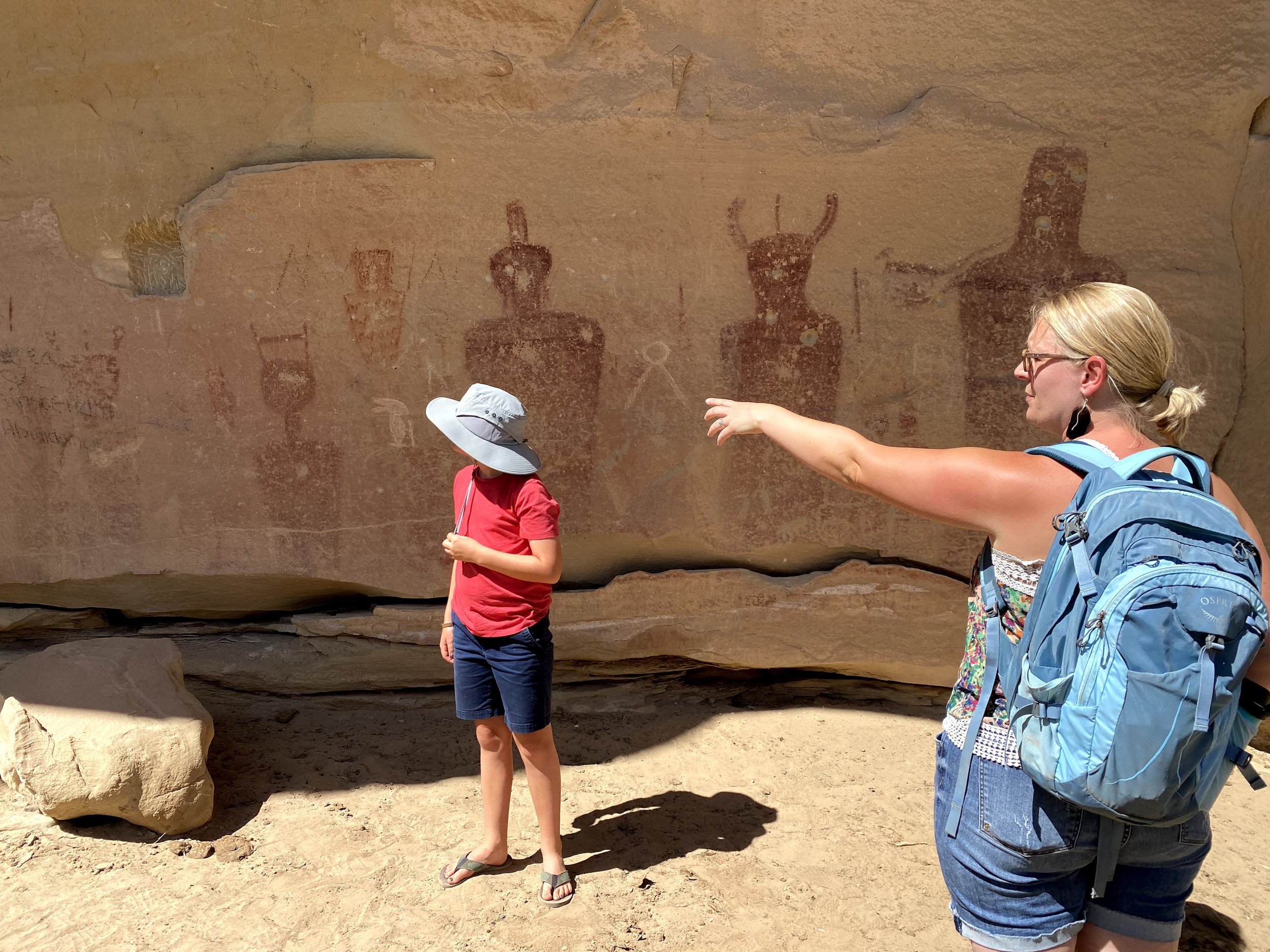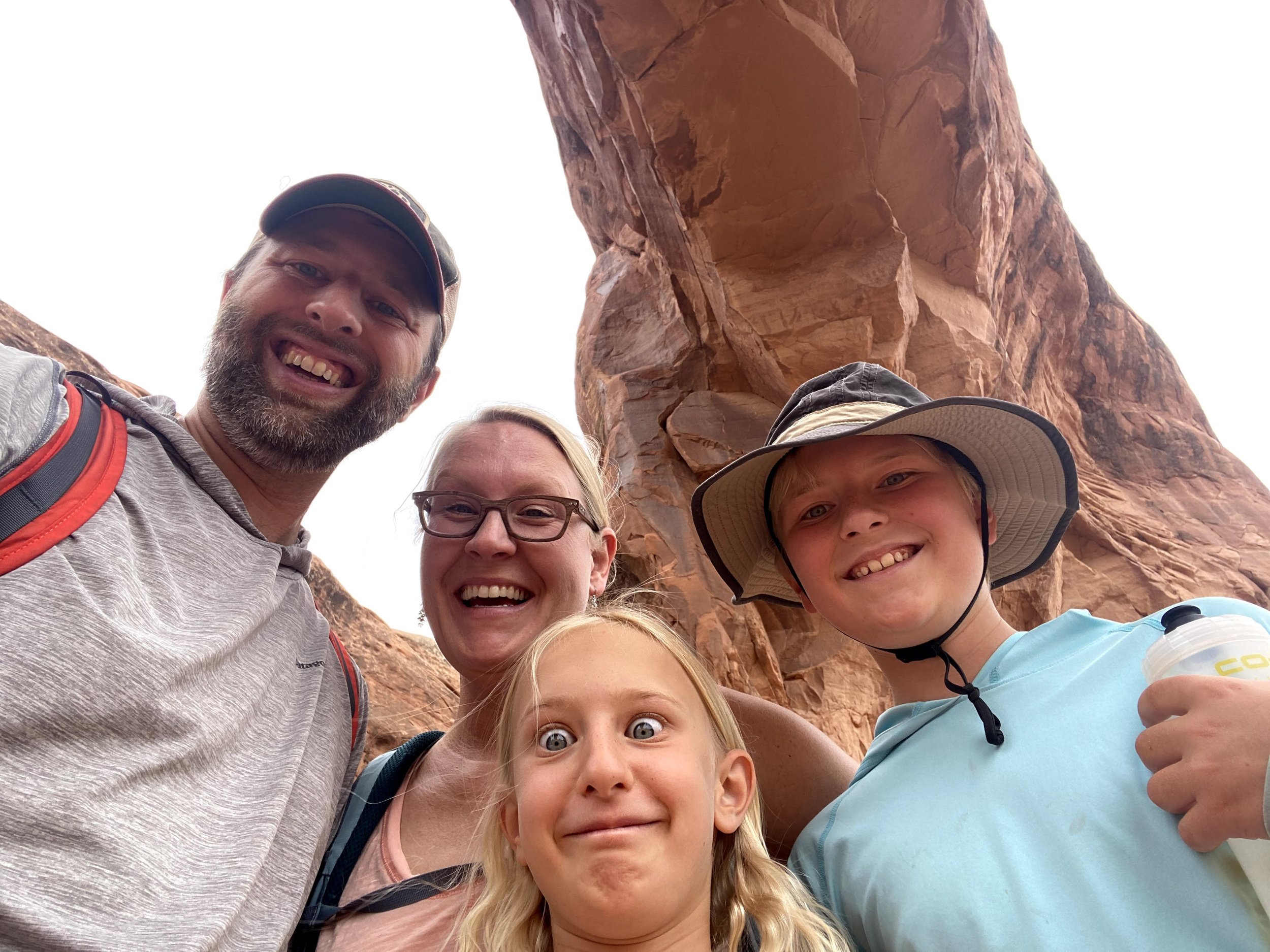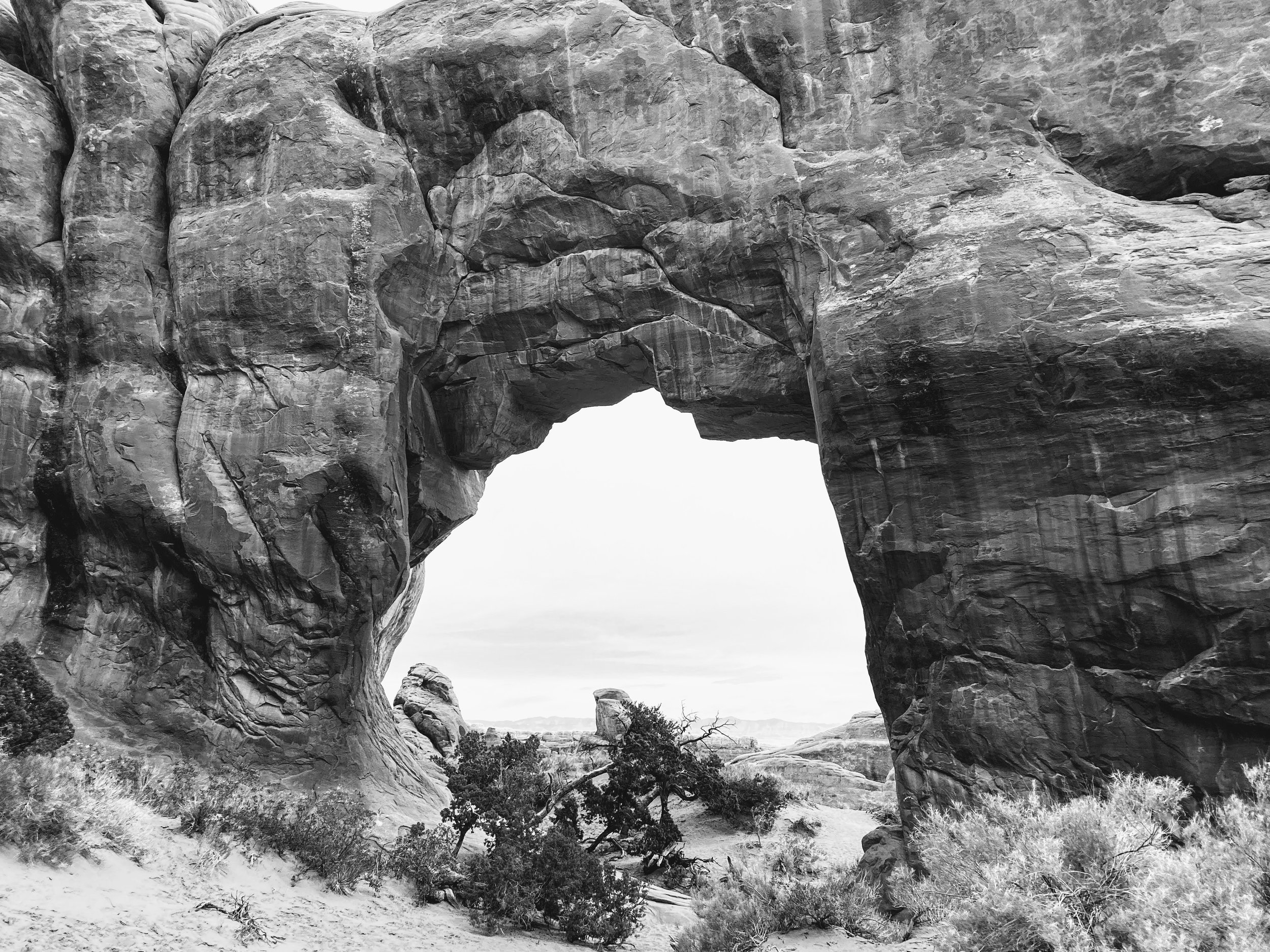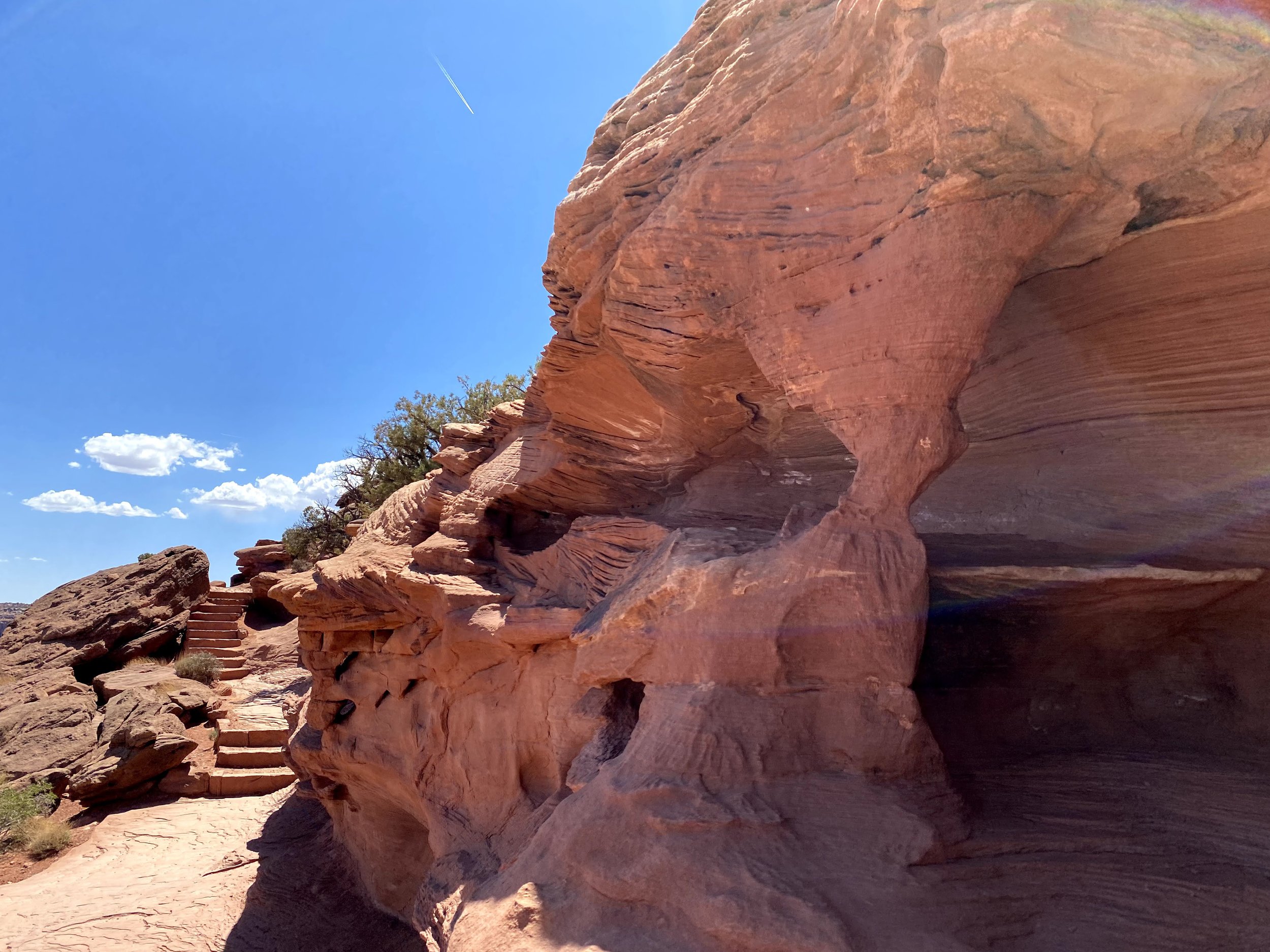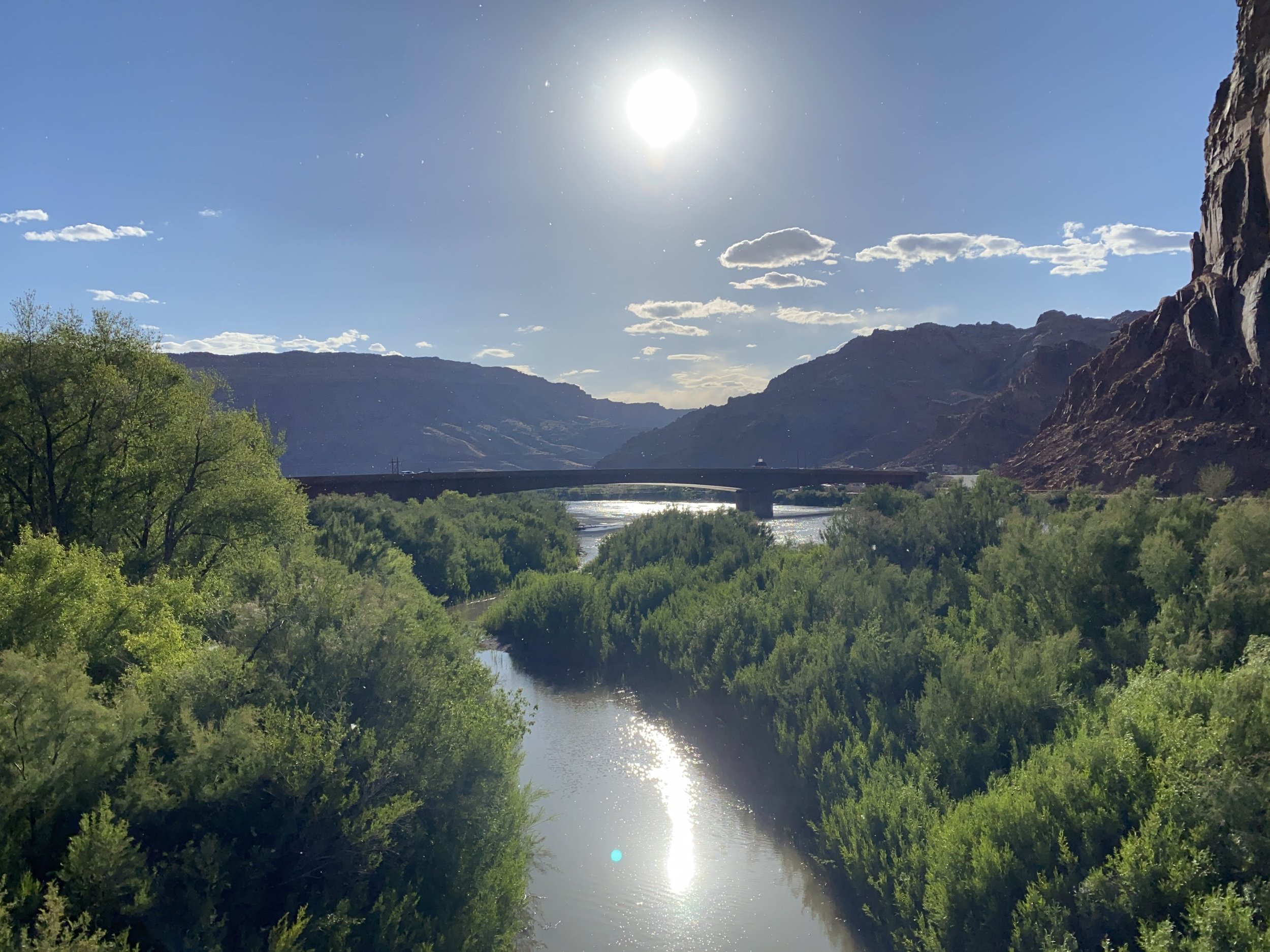Adventure Central: Moab
We’re here at the end of the spring high season, and it is packed. The KOA here charges $100/night - if you can get in. We couldn’t of course, since we plan just a few months out at most. So our time here was shaped by where we could actually stay.
For the first week, that meant the only RV park with room. 45 minutes north of Moab, in a ghost town named Thompson Springs. It sure looked closer to Moab on the map… but it’s not. Thompson Springs was a railway stop in the 1880s, though it saw human settlement back to ancient times. The nearby coal deposits saw the town boom from about 1911-1950, but the coal dried up and the Interstate passed it by, and well… there’s not much left. All of 39 residents remain, operating two RV parks, a hotel and cafe that’s open sometimes, and a gas station. Most folks stopping here are coming to get fuel, dump their RV tanks, or if they want to go further in, to see the wonderful Barrier style pictographs in Sego Canyon.
The pictographs are worth a stop, but not really a week’s stay. So it was a pretty quiet week. Being 45 minutes outside of Moab meant that the closest grocery store was actually 26 miles due West, in Green River. I think we went into Moab twice that week, once to scout out the boondocking sites for the following week, and once to hike and have dinner.
The hike was in Grandstaff Canyon, which is a beautiful oasis of a canyon that is a popular hike but absolutely worth it. Beautiful views in all directions, abundant water and rocks to climb. We haven’t hiked by a stream in a long time, we could hardly get the kids away from the water’s edge long enough to see much of the trail!
As for dinner, we have two birthdays to celebrate here, and for Kristin we found a wonderful sushi place. Being from the west coast, I’m naturally suspicious of inland sushi. But what this place lacked in still-salty fresh cuts, they made up for with creative rolls and outstanding gluten free options, including tempura fried Oreos of all things, which were even better than they sound.
The next day, Sunday - figuring that most travelers would have vacated the good boondocking spots - we headed into the BLM land in Moab, down Willow Springs Road. Of the BLM options off US-191, this looked the most friendly to our rig, and indeed it was… mostly. We’ll get to that.
Boondocking in Moab in late spring is hot, dusty, and bright. This is the latest in spring that I’d ever want to be here, that’s for sure. Any hotter and it would be incredibly difficult to see the parks and enjoy the space. So I’m glad we’re here now, as it’s the soonest we could get here anyway, and it’s absolutely gorgeous.
Unlike our Grand Canyon stay, this is not a quiet spot. We’re literally right next to the road, and have all manner of ATVs, UTVs, overlanders, RVs, and home made adventure vehicles roaring by all day long and some into the night. If we open the windows on the side by the road, we’ll get clouds of dust blowing into our living room. Most people that camp here make themselves scarce during the daytime - the BLM land isn’t why any of us are here. It’s the parks!
And oh, those parks. Kanab has nothing on the ease of access to absolutely insane landscapes that Moab offers. While Grand Canyon and Zion are much flashier than Arches or Canyonlands, they’re harder to get to and in Zion’s case, downright uninviting it’s so busy. Arches is getting there - waits at the gate can be over an hour - but they don’t do timed entry and if you go at sunrise or sunset you can usually drive right in.
But the parks aren’t even the whole story. This is 4x4 central, a mountain biking pilgrimage site, and a landscape photographer’s fantasy tour. The appeal is broad and continually rewarding the harder you work to enjoy it. Moab has done an impressive job rising to meet the demand, which seems endless. Ample food options, hotels, free water and bathrooms at the park by the river, good restaurants, and a wide selection of outfitters, tour guides, expedition rentals, and more.
I had some days off this week, which made exploring all this stuff a lot easier. We kind of had to cram stuff in though. The heat made it challenging, just being out in it is really draining, not to mention trying to hike or cycle any distance in it.
Monday night we headed out for a “quick, 15-minute bike ride” to see some nearby dinosaur tracks just down Willow Springs from our campsite. Well, it turned into a “quick, 2-hour bike ride” out and back to the tracks, but it was beautiful the whole way and the tracks were very cool to see. The trip back revealed that it was all uphill to get there, and downhill on the return was a total blast - barrelling down slickrock and dirt through a wild, beautiful desert at sunset.
Our day at Arches started just a bit later than we wanted to, but we got in easily enough. Top on our list was Landscape Arch, the longest and most fragile arch on display here. It’s quite a dramatic shape, though unlike the more famous Delicate Arch, it blends into the landscape a bit, reducing the drama. To get there we drove the length of the park, enjoying its natural vistas all around. It’s always a treat to see these huge national parks with no roads, no power lines, no development visible, just pure land. From there we worked our way south back to the gate, to Sandstone Arch, Double Arch, and Wolfe Ranch (with its Delicate Arch viewpoint).
Sandstone was really neat, it’s hidden in the narrow space between huge fins. It’s not big or dramatic, but you can walk right up to it, and it’s a fun space to be in. Double Arch is similarly interactive, but much larger. It reminded me of a cathedral in the open air!
Arches is a funny place, for as busy as it can be and hard to get in, it’s not like, Glacier or Yosemite levels of beauty everywhere you turn. (With the caveat that we didn’t get to see the Fiery Furnace, a truly unique hike that sadly is closed for Covid.) It’s beautiful, yes, and like all National Parks a special spot worth preserving. Kind of reminded me of Joshua Tree a little bit - you can drive through it in a few hours, but the True Park requires time, walking, and experience.
But if any park exemplifies that dynamic, Arches’ next door neighbor Canyonlands is it. At 300,000 acres - 1/10th the size of Death Valley - Canyonlands still manages to feel endlessly large. A vast, dry landscape carved into countless canyons, ravines, and formations, it makes for tremendously difficult travel by almost any method. You can take it in from the viewpoints, but there’s no seeing “all” of it.
We didn’t even try, as it happened. It was a long day at Arches and we did Canyonlands the next day. (I don’t recommend this.) Kristin was not feeling well - very overextended - but the kids and I were doing OK so we took a “it’ll be cool to see whatever we can” approach. Getting into the park can take a while since many folks visiting Moab see both parks, so even though it’s much further from town than the right-next-door Arches, the line was a bit long. The kids and I did the driving tour down to Grandview point at the south end of Island in the Sky, which was wonderful - but by the time we were done it was scorching hot. I shudder to think what a visit here in high summer would be like.
Unlike Grand Canyon, Canyonlands’ size doesn’t photograph particularly well from the viewpoints. It just looks flat and repetitive. I think it’s the sort of place that would take some real adventure-vehicle, desert-hiking skills to see the best of.
On my last day off we squeezed in some mountain biking on the nearby Klonzo trail system. We didn’t go out to the world-famous Slickrock trail, but we wanted to be sure and ride some trails of that type while we’re here. Klonzo is a nice little system just a mile or so from where we camped. It was another hot morning, and Kristin sat this one out too, but the kids and I had a blast. Moab is a serious mountain biking destination, and if/when we return we’ll be sure to fit in a lot more of it.
After a hot, dusty week on BLM land we were ready to be clean. So our exit plan from Moab involves leaving Saturday morning to go back to Thompson Springs for a night to hook up and clean up. It’s only 40 minutes away, but getting there… took over 2 hours.
We knew hitching up would be tricky, being that just getting the truck out of the sand after parking here took a while. We dreaded it off and on as the week went by. It ended up being a full hour out in the hot morning sun. We approached it from a couple directions, even tried a 90-degree hookup where the truck is at a right angle to the hitch (don’t recommend that one). We had a passerby on a motorbike helping out for a while. We packed down sand, stomping and worrying. We took turns driving and spotting. In the end, the 4 wheel drive low gear with aired-down tires did the trick, as we pulled the front of the truck further into the soft sand than felt wise, but it was enough to clear the trailer and let us back into the hitch… finally. From there we had to go further into the boondocking area so we could park, air up the tires, and get turned around. Only then could we actually leave for the RV park. Thankfully it wasn’t far away!
Once there we had the whole rest of the afternoon, and we couldn’t really rest after that since we’re traveling Sunday and we need this time to clean. So we parked, connected, and set to cleaning. It was a “first you play, then you pay” kind of afternoon. But I’m glad we did, because our original itinerary had us just dumping on the way out of town and driving straight to Silt, Colorado 180 miles away. Now we can make that drive clean, fresh and early. Onward!







